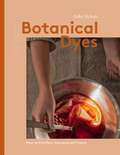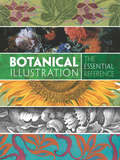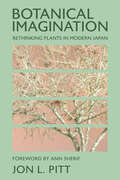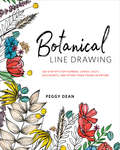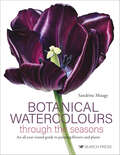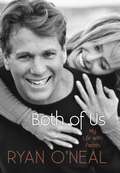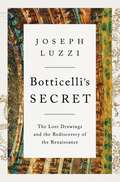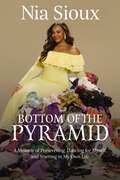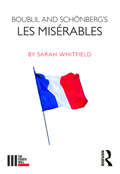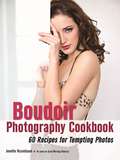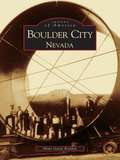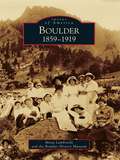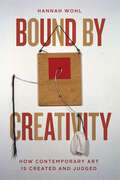- Table View
- List View
Botanical Drawing: A Step-By-Step Guide to Drawing Flowers, Vegetables, Fruit and Other Plant Life
by Penny BrownThe definitive artist's guide to drawing detailed and accurate plants, flowers and other vegetation in pencil—including illustrations and exercises.Botanical Drawing provides a thorough and expert guide to the subject, touching on the history of this fascinating art form as well as its rules and practicalities. Artist Penny Brown explains the materials, learnings and techniques required to produce accurate botanical illustrations. She also includes an accessible, basic study of botany for the absolute beginner.By following Brown’s step-by-step instructions, close studies and explorations of the subjects, you will be able to produce your own illustrations of plants, flowers, vegetables and their myriad parts. Botanical Drawing offers knowledge, techniques, and inspiration as you create your own projects.
Botanical Dyes: Plant-to-Print Dyes, Techniques and Projects (By Hand)
by Babs BehanBotanical Dyes features recipes and top tips on everything you need to know to make your own natural dyes. The process of turning plants into print can help you reconnect with nature, find a creative outlet and develop a mindful sense of presence. It also promotes an awareness of sustainable practices and how to reduce our impact on the planet. Extracting from and updating her book Botanical Inks, Babs talks the home crafter through everything from foraging for dyes, making mordants, creating an array of colours and then putting your new knowledge to the test through a collection of simple projects. With more than 15 dye recipes, clear step-by-step instructions, troubleshooting tips and explanations of what works and why, Botanical Dyes is the accessible handbook that modern makers everywhere have been waiting for.
Botanical Embroidery: 25 Designs to Mix & Match: 4 Elegant Projects
by Brian HaggardBring the beauty of nature to your quilts and needlework projects with this guide featuring 25 mix-and-match botanical embroidery motifs.Quilt artist Brian Haggard is well known for his elegant embroidery designs. In Botanical Embroidery, he shares twenty-five easy-to-follow patterns that evoke the delicate lacework of flowers and plants. This pattern pack includes complete instructions for four charming projects and iron-on transfers with endless creative applications. A robust gallery of ideas will help you incorporate nature’s colors and forms into your next hand-sewing project.
Botanical Entanglements: Women, Natural Science, and the Arts in Eighteenth-Century England
by Anna K. SagalTo this day, women face barriers in entering scientific professions, and in earlier eras the challenges were greater still. But in Botanical Entanglements, Anna Sagal reveals how women’s active participation in scientific discourses of the eighteenth century was enabled by the manipulation of social and cultural conventions that have typically been understood as limiting factors. By taking advantage of the intersections between domesticity, femininity, and nature, the writers and artists studied here laid claim to a specific authority on naturalist subjects, ranging from botany to entomology to natural history more broadly.Botanical Entanglements pairs studies of well-known authors—Eliza Haywood, Charlotte Lennox, Maria Edgeworth, and Charlotte Smith—with authors and artists who receive less attention in this context—Priscilla Wakefield, Maria Jacson, Elizabeth Blackwell, Henrietta Maria Moriarty, and Mary Delany—to offer a nuanced portrait of the diverse strategies women employed to engage in scientific labor. Using socially acceptable forms of textual production, including popular periodicals, didactic texts, novels, illustrated works, craftwork, and poetry, these women advocated for more substantive and meaningful engagement with the natural world. In parallel, the book also illuminates the emotional and physical intimacies between women, plants, and insects to reveal an early precursor to twenty-first-century theorizing of plant intelligence and human-plant relationships. Recognizing such literary and artistic "entanglement" facilitates a more profound understanding of the multifaceted relationship between women and the natural world in eighteenth-century England.
Botanical Illustration: The Essential Reference
by Carol Belanger GraftonComprising more than 500 years of printed botanical illustrations, this stunning compendium of black-and-white and color images begins with medieval illuminated manuscripts and woodcuts from the early days of printing. In addition to images from the fifteenth and sixteenth centuries, the collection features highlights from such seventeenth-century classics as Gerard's Herbal, Besler's Hortus Eystettensis, and Crispin van de Pass' Hortus Floridus. Latter-day selections include illustrations from major nineteenth-century works -- including the great flower prints of Pierre-Joseph Redouté and hand-colored lithographs by many other artists of the period -- as well as the imaginative twentieth-century floral work in the Art Nouveau style of M. P. Verneuil, E. A. Seguy, and others.Detailed bibliographical information concerning every source and biographical information on the artists make this volume a vital reference tool as well as a splendid resource of significant and beautiful botanical illustrations. Students of graphic art and illustration as well as graphic designers, advertising professionals, and horticulturalists will prize this treasury of material from many rare historic sources.
Botanical Imagination: Rethinking Plants in Modern Japan (The Environments of East Asia)
by Jon L. PittBotanical Imagination explores the complicated legacy and enduring lure of plant life in modern Japanese literature and media. Using critical plant studies, Jon L. Pitt examines an unlikely group of writers and filmmakers in modern Japan, finding in their works a desire to "become botanical" in both content and form. For nearly one hundred years, a botanical imagination grew in response to moments of crisis in Japan's modern history.Pitt shows how artists were inspired to seek out botanical knowledge in order to construct new forms of subjectivity and attempt to resist certain forms of state violence. As he follows plants through the tangled histories of imperialism and state control, Pitt also uncovers the ways plants were used in the same violence that drove artists to turn to the botanical as a model of resistance in the first place. Botanical Imagination calls on us to rethink plants as significant but ambivalent actors and to turn to the botanical realm as a site of potentiality.
Botanical Inks: Plant-to-Print Dyes, Techniques and Projects
by Babs BehanLearn how to transform foraged wild plants, plants, garden produce and recycled food into dyes and inks with Botanical Inks.The book shows you how to extract environmentally sustainable colour from the landscape and use it to create natural dyes for textiles, clothing, paper and other materials.Botanical Inks covers dyeing and surface application techniques, including bundle dyeing, Shibori tie-dyeing, hapazome, indigo sugar vat dyeing, wood-block printing, screen printing and more. And it also shows you how to turn your new inks, dyes and technique knowledge into wonderful projects, from a simple bundle-dyed a scarf to a block-printed tote bag.The process of turning plants into print can help you reconnect with nature, find a creative outlet and develop a mindful sense of presence. It also promotes an awareness of sustainable practices and how to reduce our impact on the planet.
Botanical Line Drawing: 200 Step-by-Step Flowers, Leaves, Cacti, Succulents, and Other Items Found in Nature
by Peggy DeanFrom the artist behind the popular Pigeon Letters website, an easy, no-skills-necessary guide to drawing flowers, leaves, and cacti with 200 step-by-step prompts.Line drawing is an easy-to-master art form featuring illustrative, doodle-like designs. It's used widely among artists of many types with both fine and bold lines, creating different variations. Botanical Line Drawing teaches you how to start with the simplest doodles, building into more elaborate, delicate illustrations. This book focuses on the extremely popular subject matter of the natural world and includes flowers, leaves, succulents, houseplants, trees, branches, mushrooms, and more. These simple line drawings will allow you to branch out and have fun with your own personal style, as well as inspire you to add flourishes to other projects.
Botanical Soaps: A Modern Guide to Making Your Own Soaps, Shampoo Bars and Other Beauty Essentials
by Marta TaralloSustainability is creeping into all aspects of our lives. The beauty industry is one of the biggest polluters, littering our oceans with used plastic bottles and containers. In response to this there is growing movement of people looking for cleaner and greener way to beautify.Learn how to simplify your beauty regime with Botanical Soaps as this book shows you how to create your own beauty products using all natural ingredients. Demystify your skin type and discover how to combat bathroom plastic, minimise your routine by making your own soaps, shampoo bars and other beauty products including, lip butters, cleansers, bath salts and natural deodorants.Botanical Soaps is a beautiful and inspiring lifestyle guide that will encourage you to green up your beauty regime with all natural, organic projects that are kinder to both the planet and your skin.
Botanical Watercolours through the seasons: An All-Year-Round Guide to Painting Flowers and Plants
by Sandrine MaugyThis stunning book follows the rhythm of nature through the year.Botanical Watercolours through the Seasons begins with a detailed introduction to Sandrine's ethically-sourced materials and tools, her workspace and an exploration of the key techniques employed in painting botanical watercolours. Sandrine explains colour theory in relation to botanical subjects, as well as colour bias and the key to creating realistic shadows without resorting to an unnatural 'grey'. The four main chapters focus on a particular season and contains techniques for painting its plants: for example, papery bulbs in spring and jewel-like berries in winter, along with examples of the author’s stunning botanical artwork. Each chapter includes three step-by-step tutorials: the first for relative beginners; the second for artists of intermediate level and the third for more experienced artist. Subjects range from bold spring daffodils, delicate summer sweet peas, through to whimsical autumn ginkgo biloba leaves, and finishing with a striking holly star composition to close the winter chapter.With a foreword from Tom Brown, Head Gardener at West Dean College of Arts and Conservation: "It is Sandrine’s botanical knowledge that sets her apart, [...] through [her] guidance we can learn to celebrate and document the natural rhythms of our green spaces around us." Readers can work through the book season-by-season, or focus on the plants they know and love. All the recommended materials used in the book are ethically sourced: the paper is from sustainable sources, the brushes are cruelty-free and the paints are vegan.
Both of Us: My Life with Farrah
by Jodee Blanco Ryan O'Neal Kent CarrollRyan O'Neal and Farrah Fawcett. He was the handsome Academy Award-nominated star of Paper Moon and the classic romance Love Story. She was the beautiful, all-American Charlie's Angel, whose poster adorned the bedroom walls of teenage boys everywhere. One of the most storied love affairs in Hollywood history, their romance has captivated fans and media alike for more than three decades. In a tragic turn, the world lost Farrah after a tragic battle with cancer in 2009, but in his intimate memoir Both of Us, Ryan brings their relationship to vivid life. Fans of each other from afar, Ryan and Farrah met through her husband, Lee Majors, and fell passionately in love. Soon, however, reality threatened their happiness and they struggled with some serious matters, including the disintegration of Farrah's marriage; Ryan's troubled relationship with his daughter, Tatum, and son, Griffin; mismatched career trajectories; and raising their young son, Redmond--all leading Ryan and Farrah to an inevitable split in 1997. Ryan fought to create a life on his own but never stopped longing for Farrah. Eventually he realized that he had lost his true soul mate. Older and wiser, he and Farrah found their way back to each other and were excited to start a new life together. But their bliss was cut short when Farrah was diagnosed with cancer and passed away just three years later. Ryan's deep love for Farrah and his devotion to preserving her memory are evident in Both of Us. Drawing on decades' worth of personal records and keepsakes, he has included never-before-seen photographs, letters exchanged between him and Farrah, and his own diaries, making this a poignant and compelling memento for her fans. Written with candor and emotional honesty, it is a true Hollywood love story.
Bothell (Images of America)
by Margaret TurcottThe river community of Bothell began with the arrival of Columbus Greenleaf and George Wilson in 1870. They staked claims along the Sammamish River after navigating from Seattle across Lake Washington and then east along the meandering Sammamish. Bothell was first a logging community, with several mills producing boards and shingles. After the forests were harvested, it became a farming community, connected to other settlements by the river and, after 1887, the railroad. In 1909, Bothell incorporated as a city after a contentious campaign. The vote was 79 to 70 in favor of becoming a city. The population of Bothell in 1910 was 599, but many lived outside the two-thirds square mile original city limits. This book tells the story of Bothell as a central hub, with distinct neighborhoods having their own personalities. Bothell’s population today is almost 43,000, divided between two counties: King and Snohomish.
Botticelli's Secret: The Lost Drawings And The Rediscovery Of The Renaissance
by Joseph Luzzi“Brilliantly conceived and executed, Botticelli's Secret is a riveting search for buried treasure.” —Stephen Greenblatt, author of The Swerve Some five hundred years ago, Sandro Botticelli, a painter of humble origin, created works of unearthly beauty. A star of Florence’s art world, he was commissioned by a member of the city’s powerful Medici family to execute a near-impossible project: to illustrate all one hundred cantos of The Divine Comedy by Dante Alighieri, the ultimate visual homage to that “divine” poet. This sparked a gripping encounter between poet and artist, between the religious and the secular, between the earthly and the evanescent, recorded in exquisite drawings by Botticelli that now enchant audiences worldwide. Yet after a lifetime of creating masterpieces including Primavera and The Birth of Venus, Botticelli declined into poverty and obscurity. His Dante project remained unfinished. Then the drawings vanished for over four hundred years. The once famous Botticelli himself was forgotten. The nineteenth-century rediscovery of Botticelli’s Dante drawings brought scholars and art lovers to their knees: this work embodied everything the Renaissance had come to mean. From Botticelli’s metaphorical rise from the dead in Victorian England to the emergence of eagle-eyed connoisseurs like Bernard Berenson and Herbert Horne in the early twentieth century, and even the rescue of precious art during World War II and the fall of the Berlin Wall in 1989, the posthumous story of Botticelli’s Dante drawings is, if anything, even more dramatic than their creation. A combination of artistic detective story and rich intellectual history, Botticelli’s Secret shows not only how the Renaissance came to life, but also how Botticelli’s art helped bring it about—and, most important, why we need the Renaissance and all that it stands for today.
Bottom of the Pyramid: A Memoir of Persevering, Dancing for Myself, and Starring in My Own Life
by Nia Sioux"Sioux&’s harrowing reality TV ordeal cuts deep, and her subsequent self-assurance is endearing and infectious. It adds up to an inspiring account of reclaiming artistic agency.&” - Publisher&’s WeeklyWhen you&’ve been told over and over that you belong at the bottom, how do you come out on top? Dance Moms star and triple threat Nia Sioux shows the way via her story of resilience, triumph, and defining success for herself.Young dancer Nia Sioux was only nine years old when she stepped into stardom as one of the original cast members of Lifetime&’s reality TV show Dance Moms. Nia learned new choreography week after week and competed against dancers from across the country as well as at her own studio. Perhaps her greatest obstacle was suffering through her dance teacher&’s ranking of the girls against each other in her infamous pyramid, where Nia spent the majority of her time on the bottom—all in front of an audience of millions.But there was much that viewers didn&’t see. How her experiences in the studio went far beyond what made it into the show. How she was ostracized for not fitting into an aesthetic that wasn&’t designed for girls like her. How her friendships and her mental health crumbled under the strain of the show. How she lost control of her story and her voice.But don&’t be fooled—this is a story about resilience. Nia is not looking for pity, sympathy, or validation as she reflects on her experiences. Instead, she is choosing to use her story as a celebration of triumph. Nia finally gets to tell her story in her own way and in her own words. In this captivating memoir, Nia reclaims both the spotlight and her narrative.In addition to going behind the scenes of the seven seasons of Dance Moms, she shows how she fought against the negative perceptions that dominated her tween and teen years and emerged as a confident young woman secure in her talents and her direction. Anyone who has ever felt misunderstood, overlooked, or stuck at the bottom of the pyramid will be inspired by Nia&’s story of overcoming. &“Despite barriers and constant naysayers, assumptions and criticisms, only you know who you are inside and out,&” Nia says. &“And you have the power to create your own narrative, your own level of success.&”
Botánicas: Sacred Spaces of Healing and Devotion in Urban America
by Joseph M. MurphyBotánicas is an exploration in text and photographs of spiritual shops found in Latino neighborhoods throughout the United States. Readers discover these marvelous spaces and their alternative spiritualties that help patrons cope with the grind and challenges of city life. Botánicas provide access to an array of invisible powers and sell the ingredients to construct symbolic solutions to their patrons' problems. The stores are bright and baroque, and the powers they invoke come from religious traditions in Africa, Europe, Asia, and the native Americas. In Botánicas, Joseph M. Murphy offers a cultural history of the devotions on display and a reflection on the efficacy of their powers to heal. Readers will come to see that the goods and devotions of botánicas give their patrons--mostly Latino, often immigrants--pathways for empowerment and transformation.The name botánicas comes from the "botanicals" for sale, herbs and plants with healing powers. The pharmacopeia of botánicas can be vast, and owners may know hundreds of remedies for treating problems of health, wealth, and love. Botánicas vend herbs for upset stomach, herbs for finding a job, and herbs for wooing back a wayward spouse. Supplementing these medicinal and magical plants, botánicas sell candles, holy statues, and tools for devotion to an array of spiritual powers--Catholic saints, African gods, indigenous spirits, and Asian divinities. Each spirit has its own ritual of petition, and botánica owners can discern the proper offerings and prayers to help the supplicant.Murphy explains the religions of the botánica with subtlety and sensitivity. He gives readers a deep sense of the contexts of the stores and a sophisticated analysis of the religious traditions that suffuse them. Visually fascinating, culturally rich, and religiously profound, Botánicas is a window into a world of beauty and power.
Boublil and Schönberg’s Les Misérables (The Fourth Wall)
by Sarah Whitfield"One more dawn! One more day! One day more!" Did Les Misérables make you miserable? Or did it inspire you? When Sarah Whitfield was a teenager, her Dad frequently embarrassed her with his love of this musical above all others. So, after he was diagnosed with late stage cancer, Whitfield set out to find out why this musical meant so much to him and to its worldwide following. In this new book, she asked her Dad and 350 other people how they felt about this musical, exploring people’s personal connections with the show. In the middle of some of the hardest moments in family life, Whitfield explores how the musical might help us deal with some of our most difficult experiences and give us hope for when ‘tomorrow comes’.
Boudoir Lighting
by Robin OwenThe most flattering boudoir images are often very nuanced presentations of the subject's sensuality-but that doesn't mean that the lighting has to be extremely complicated. For most of the beautiful images in this well-illustrated book, photographer Robin Owen uses just a single light source. As she shows, the key to getting great results with simple setups is careful planning. From there, careful posing within the light allows you to emphasize your subject's best features and minimize any areas she feels less confident revealing. By observing the delicate balance between lighting and posing, Owens shows you how to create a broad spectrum of looks that will satisfy virtually any boudoir client. As you follow through Owen's detailed descriptions of her work on sixty different sessions, you'll quickly discover that lighting a boudoir portrait doesn't have to be a daunting prospect-with a little creativity and ingenuity, simple can be absolutely beautiful!
Boudoir Lighting
by Robin OwenBoudoir portraits are intimate by nature. The provide an intimate, private look at subjects and are intended for those who have a close emotional relationship with the subject-or in some cases, are made for the subject herself.Creating images that capture the romantic, sensual side of a subject requires a masterful approach. All components of the photography-from the photographer-client relationship, to the setting, to the clothing selection, to the posing and lighting, must be carefully thought out and flawlessly executed.In this book, Robin Owen shows off her uncanny skill at creating 60 sweet and sexy images of women and couples. As you turn the pages, you'll find discussions detailing the artistic approach used to photograph each client-and you'll see alternate shots from the session, which are sure to inspire additional ideas for your own boudoir clients.From one page spread to the next, Olson provides important insights into sculpting the look you are after. You'll learn to work with unexpected lighting configurations and modifiers. You'll find and learn how to create unlikely settings-among many other creative considerations that allow you to create images that stand out from the competition. With a surprising array of image looks to inspire your creativity and targeted technical discussions, this book provides both the impetus and the know-how you're after to get out there and create unforgettable images.
Boudoir Photography Cookbook
by Jen RozenbaumJen Rozenbaum presents sixty essential skills that will help you to fine-turn every aspect of your boudoir shoot. She begins with a look into what qualifies as boudoir, identifies the subgenres of boudoir portraiture, and then launches into a targeted look at various posing strategies that will really amp up your subject's gorgeous curves for a sexy, sultry look. You'll also find a host of image concepts that you might want to incorporate into your repertoire, plus lighting sources and setups Jen favors for creating sizzling shots, and even tips for selecting a wardrobe that downplays perceived flaws and celebrates your subject's assets. Of course, Rozenbaum doesn't stop there. There are even sections on changing up lenses for portrait variety, working with a Lensbaby (a specialty lens that offers a 'sweet spot' of focus), and pulling out all of the stops with today's must-have light source: the Westcott Ice Light.
Boudoir Photography: The Complete Guide To Shooting Intimate Portraits
by Critsey RoweGraffiti Art has blazed a trail across the world, with amazing examples visible in every modern city, but its pioneers were the New Yorkers who painted whole subway cars. <P><P> For a few years in the 1970s and '80s, their creations made New York's subway system a unique, constantly evolving gallery of a new art form - a visual counterpoint to hip-hop and rap music, and a powerful expression of urban culture. It couldn't last; the city authorities made powerful efforts to stop the artists, but their visual inventiveness has left a permanent mark on the urban art landscape. Now, with The Subway Graffiti Sketchbook, today's graffiti artists will be able to go back to the medium's roots and find inspiration without fear of electrocution or arrest. The book contains 54 accurate line drawings of subway carriages, some with color or black-and-white line art on them to help you get started, but most clean and ready for use. The high-grade uncoated art paper enables you to use pencil, paint or marker pen, and the unique concertina binding will allow you to create amazing sequences of customized cars, perfect for display or just honing your skills.
Boulder City, Nevada
by Mimi Garat RoddenThe Boulder Canyon Project Act, authorized by Congress in 1928, designated funds for the construction of the Hoover Dam. This monumental undertaking affected the interests of seven states and is considered by many to be the most significant American public works project of the 20th century. A project of this scope required thousands of workers, and to meet their needs, the Bureau of Reclamation planned the town of Boulder City, Nevada. Today, the planning of Boulder City is recognized as a significant influence on modern city planning. To a country shaken to its roots by the tumultuous effects of the Great Depression, the Hoover Dam project provided two essentials that were in short supply: work and housing. With the planned community of Boulder City, there was yet another benefit--an oasis in the desert, a city with character and charm. From the hot, barren, cactus-covered land rose green lawns and gardens, workers and their families created a new sense of community, culled from their hard work and the massive dam that was rising before their eyes.
Boulder City: The Town that Built the Hoover Dam (Brief History)
by Paul W. PapaIn the depths of the Great Depression, the United States undertook a task so monumental it demanded nearly five thousand people to complete. The Hoover Dam stands as a modern marvel, a testament to America’s ingenuity. However, few know the story of the town that built the dam. To house the workers, Secretary of Interior Ray L. Wilbur envisioned a model of city planning, giving birth to Boulder City. Wilbur intended for the city to be temporary, to disappear once the dam was complete, but it didn’t work out that way. Local author Paul W. Papa offers a unique look at a town that may have been forged by a dam but took on a life of its own.
Boulder: 1859-1919
by Boulder History Museum Mona LambrechtBorn out of the 1859 Pikes Peak gold rush, Boulder sits along the Front Range where the Rocky Mountains meet the plains. Discoveries of gold, silver, telluride, and coal nearby put the little supply town on the map, and early miners, farmers, and businessmen prospered there. The railroad's arrival in 1873 brought more newcomers who cultivated a diverse community full of new businesses, social organizations, and schools, and the town flourished despite the social problems and economic fluctuations that were typical of early mining towns. By the 1890s, education, health, and tourism had become significant to Boulder's economic development, a pattern that continues to this day. Great change came about during the early 1900s in the form of a citywide alcohol prohibition, the influenza epidemic, and the closure of the "Switzerland Trail" railroad in 1919, but Boulder weathered these difficult times even as it witnessed the end of the great railroading era.
Bound & Determined: A Visual History of Corsets, 1850--1960
by Kristina SeleshankoThis revealing history of corsetry ranges from the 19th through the mid-20th centuries to show how simple laced bodices developed into corsets of cane, whalebone, and steel. Lavish illustrations include line drawings and photographs from a diversity of sources, such as clothing catalogs, newspaper and popular magazine advertisements, and magazine articles.
Bound by Creativity: How Contemporary Art Is Created and Judged
by Hannah WohlWhat is creativity? While our traditional view of creative work might lead us to think of artists as solitary visionaries, the creative process is profoundly influenced by social interactions even when artists work alone. Sociologist Hannah Wohl draws on more than one hundred interviews and two years of ethnographic research in the New York contemporary art market to develop a rich sociological perspective of creativity. From inside the studio, we see how artists experiment with new ideas and decide which works to abandon, destroy, put into storage, or exhibit. Wohl then transports readers into the art world, where we discover how artists’ understandings of their work are shaped through interactions in studio visits, galleries, international art fairs, and collectors’ homes. Bound by Creativity reveals how artists develop conceptions of their distinctive creative visions through experimentation and social interactions. Ultimately, we come to appreciate how judgment is integral to the creative process, both resulting in the creation of original works while also limiting an artist’s ability to break new ground. Exploring creativity through the lens of judgment sheds new light on the production of cultural objects, markets, and prestige.

